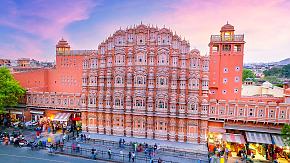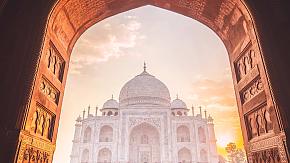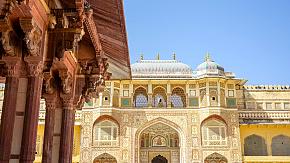Taj Mahal Story: History, Facts, and Top Tips for Visiting
The majestic Taj Mahal is India's most famous monument, set in an extensive, symmetrical garden on the Yamuna riverbank in the city of Agra. Each year, millions of people come from across the world to admire its beauty and listen to the story behind its construction. If you are considering a vacation in India, there is no reason not to discover this beautiful site. So before you go, it would be better to learn something about the fascinating history of this amazing monument.
Why Was the Taj Mahal Built
Built between 1632 and 1653, the world-famous Taj Mahal was commissioned by the Shah Jahan, the fifth emperor of the Mughal Empire that ruled most of northern India between the 16th and 18th century, to commemorate his beloved wife Mumtaz Mahal who died of childbirth complications.
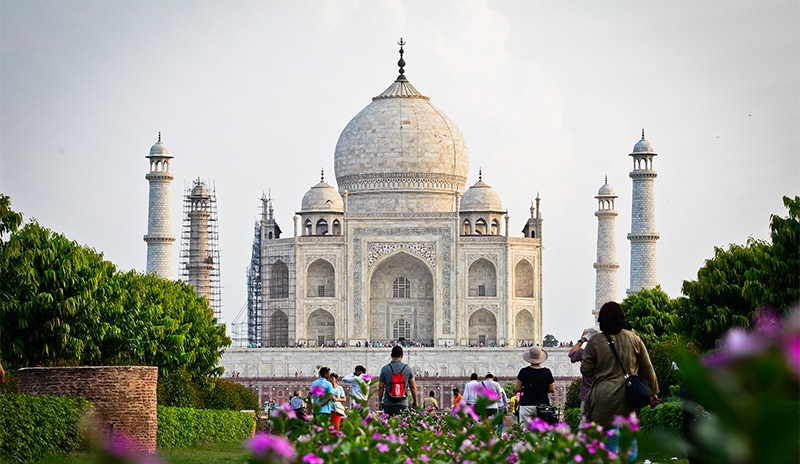 A beautiful shot of the Taj Mahal taken from the Yamuna River (Photo credit: Gene Tobia)
A beautiful shot of the Taj Mahal taken from the Yamuna River (Photo credit: Gene Tobia)
The Love Story
Shah Jahan met Mumtaz Mahal at one of the booths of the royal bazaar in 1607, long before he became the emperor of the Mughal Empire. He was then 15 years old, called Prince Khurram, and Mumtaz Mahal, 14, called Arjumand Banu Baygam, whose father would later become the prime minister. It was love at first sight. However, he didn't marry her until 1612, five years after their betrothal, after marrying Kandahari Begum, his first wife. (He would later take a third wife in 1617).
On March 27, 1612, Prince Khurram and Arjumand Banu Baygam got married. The prince gave his wife the name Mumtaz Mahal, meaning "chosen one of the palace". Despite having three wives, the prince's whole delight was centered on Mumtaz Mahal, according to Inayat Khan, Shah Jahan's historian. The couple had a loving marriage, with intimacy, and deep affection for each other. Throughout Khurram's earlier military campaigns, she always accompanied him in spite of her pregnancies. Even after Shah Jahan's accession to the throne she served as a confidant and trusted advisor who often gave him advice both on private and public matters. The public was greatly enamored with Mumtaz Mahal because of her beauty, grace as well as compassion. She helped the people in need, making sure the widows and orphans got food and money.
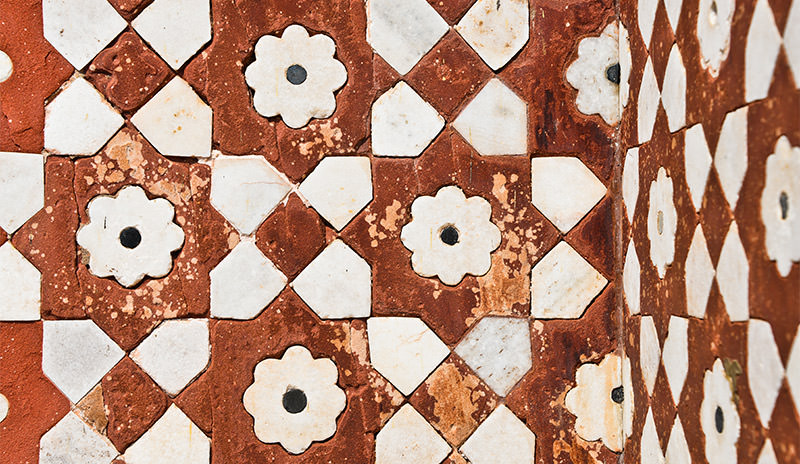 Red sandstone with marble decorations (Photo credit: Gene Tobia)
Red sandstone with marble decorations (Photo credit: Gene Tobia)
The Death of Mumtaz Mahal
In their 19 years of marriage, they had 14 children altogether, but only 7 of them lived past infancy. The birth of the 14th kid led to the death of Mumtaz Mahal. On June 17, 1631, she died in Shah Jahan's arm in a military tent after giving birth to a healthy baby girl. Her body was temporarily buried near the encampment at Burhanpur. It is said that the emperor was so sad that he started a seclusion for a year, mourning for his beloved wife. When people saw him again, his hair had turned gray and his back was bent.
In December 1631, Mumtaz Mahal's remains were carried to Agra (435 miles (700 km) from Burhanpur). Her body was escorted with thousands of soldiers, and crowds of mourners lined the road. Shah Jahan had her remains temporarily buried on a land near where Taj Mahal would be built. Still full of grief, he decided to create an exquisite mausoleum that none could rival.
The Construction of Taj Mahal
The Location
1) No one knows exactly why the final resting place of Mumtaz Mahal was chosen to be on the bank of the Yamuna River in Agra. Below are some of the possible reasons:
In the 17th century, this area was also where all the gardens and palaces of the noble Mughals were located. It was therefore justifiable that the empress should rest in peace here.
2) The Yamuna River is one of the tributaries of the Ganges, a purifying river sacred to the Hindu population. Shah Jahan hoped the soul of her deceased wife would be purified by placing her here.
3) Shah Jahan wanted to build a huge mausoleum for her wife. Thus the structure would be extremely heavy and better be supported by large wooden slabs built over deep wells, keeping the mausoleum stable. So the banks of the Yamuna River would be most suitable. The water from the river can moisturize the mausoleum's wooden foundation (mainly timber), which is key to the stabilization of the structure.
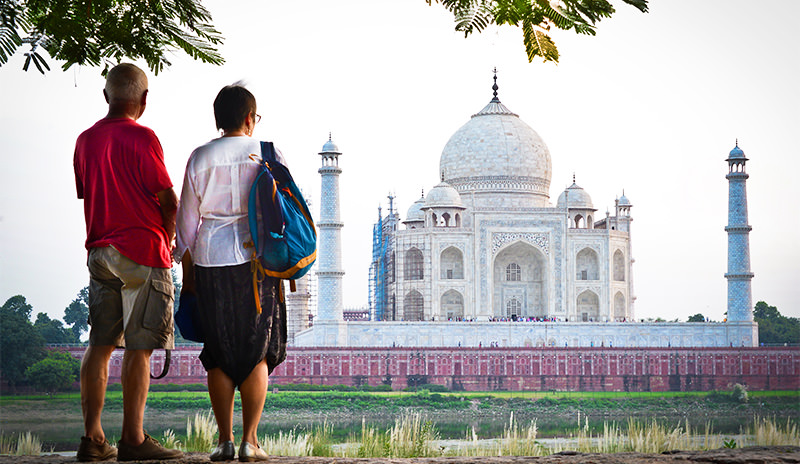 A couple enjoying the Taj Mahal across the Yamuna River (Photo credit: Gene Tobia)
A couple enjoying the Taj Mahal across the Yamuna River (Photo credit: Gene Tobia)
The Building Style
As the best example of Mughal architecture, the Taj Mahal is a fusion of Hindu and Islamic architecture, interpreting many of the Hindu traditions in an Islamic form.
The Architects and Craftsmen
It is not known exactly who was responsible for the design of the monument because at that time it was the patron who won the credit for the design of a building. But the chief architect is said to be Ustad Ahmad Lahouri, who is also credited with the design of the famous Red Fort of Delhi.
The construction of the Taj Mahal wouldn't have been possible without the teamwork of architects, draughtsmen, stonemasons, sculptors, dome builders, calligraphers, carpenters, and other workers whose number is believed to be around 20,000. Sadly, the hands of these architects and workers were all cut off by the minions of Shah Jahan so that they could never create a building like it, according to a story.
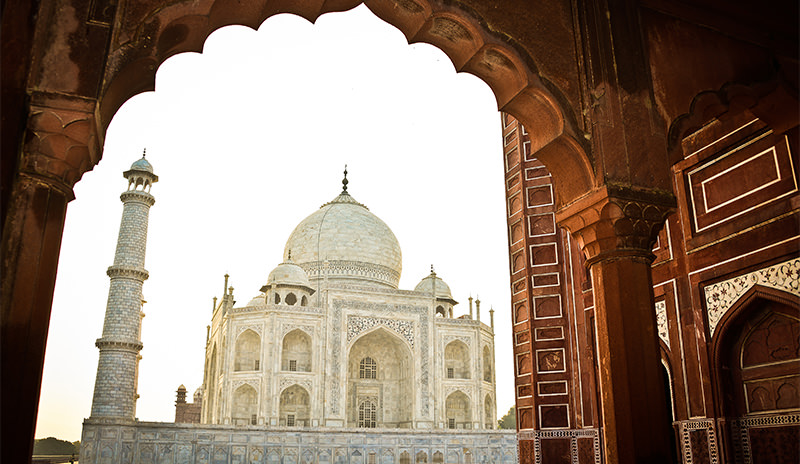 A view of Taj Mahal from the mosque (Photo credit: Gene Tobia)
A view of Taj Mahal from the mosque (Photo credit: Gene Tobia)
The Length of Lonstruction
The construction of Taj Mahal took over twenty years. It was built in 1632, and in 1648, the mausoleum was finished. Another 5 years were spent on the building of the enclosure, the ancillary buildings such as gardens, so the whole complex was completed in 1653.
The Cost of Construction
There are different stories as to how much the construction of the Taj Mahal cost. Some say the monument is estimated to have cost 32 million rupees, which is about 53 billion rupees (US$827 million) in modern values. Most of the money was spent on the stones and workers' wages. The funds were from the Royal Treasury of the Emperor and the Treasury of the Government of the Province of Agra.
The Origins of Building Materials
The materials used to build the Taj Mahal were from all over India and Asia. Some 1,000 elephants were used to carry building materials.
Here is a list of the building materials and their origins:
- Brick: Agra
- Sandstone: 28 miles (45km) away from Agra
- White marble: Makrana, 250 miles (km) away from Agra
- Jaspers: Punjab
- Jade and crystal: China
- Turquoise: Tibet
- Lapis lazuli: Afghanistan
- Sapphire: Sri Lanka
- Carnelian: Arabia
The Last Days of Shah Jahan
After the completion of the Taj Mahal, Shah Jahan was still stricken with inconsolable grief. Aurangzeb, the third of Mumtaz Mahal and Shah Jahan's four sons, took advantage of the situation to kill off his three brothers and successfully usurped his father. Shah Jahan was therefore imprisoned in the Red Fort in Agra. He spent the remaining days looking out of a window, watching his beloved wife's mausoleum. When he died in January 1666, he was buried in the mausoleum next to Mumtaz Mahal.
 The Taj Mahal seen from the Red Fort in Agra (Photo credit: Gene Tobia)
The Taj Mahal seen from the Red Fort in Agra (Photo credit: Gene Tobia)
Damage and Restoration
In its golden days, the wealthy Mughal Empire had enough money for the maintenance of the Taj Mahal. But when the empire fell (which began in 1707), the monument suffered as well. In 1857, the Mughals were ousted by the British who took over India. The beautiful gemstones from the walls were cut, and silver candlesticks and doors stolen. Fortunately, Lord George Curzon, the governor general of the Indies from 1899 to 1905, ordered a stop to the loot and initiated a restoration of the monument.
The Honors of the Taj Mahal
Undoubtedly a masterpiece of the Mughal architecture, the Taj Mahal has amazed and astounded a great number of travelers over the centuries. With its name meaning "Crown Palace",this incredible monument has achieved worldwide recognition.
- UNESCO World Heritage Site (1983) (The UNESCO also describes it as "the jewel of Muslim art in India and India's greatest architectural achievement".)
- One of the New Seven Wonders of the World (2007) voted by over 100 million people worldwide
- One of the 50 Places of a Lifetime by the National Geographic
- The Symbol of Love
- One of the Most Beautiful Mausoleums in the World
- A Teardrop on the Cheek of Time by Rabindranath Tagore, Bengali poet who won the Nobel Prize in Literature in 1913
- Asia's Leading Tourist Attraction (2012) by World Travel Awards
Famous Visitors of the Taj Mahal
Taj Mahal has intrigued and attracted millions of visitors, including internationally famous actors, actresses, CEOs, politicians, and celebrities. And here are some famous people who have visited this amazing monument.
- Leonardo DiCaprio who made a secret trip to Taj Mahal when visiting India to shoot a documentary on climate change in 2015.
- Mark Zuckerberg who made this comment about the monument in 2015: "It's incredible what people can build — and what love can motivate us to build."
- Oprah Winfrey who did the Taj Mahal trip in 2012 while shooting an episode of her talk show, Oprah's Next Chapter.
- Tom Cruise who toured the monument during a promotional trip of Mission Impossible: Ghost Protocol in 2011.
- Actress Julia Roberts who took her trip to the monument of love with her husband Daniel Moder and their children when filming the movie Eat Pray Love in India in 2009.
- The Clintons: Hillary Clinton and her daughter Chelsea visited the iconic site in 1995; Bill Clinton did the trip in 2000 with Chelsea.
- Princess Diana who sat on a bench outside the Taj Mahal during her official visit to India in 1992 and the bench is still known as Diana's bench.
- Prince Charles who visited the monument in 1980, a year before his marriage to Princess Diana.
- Beatles guitarist George Harrison made a trip to Taj Mahal in 1966. He took a photo of himself, which became one of the first celebrity selfies.
Other celebrities who visited the Taj Mahal include Vladimir Putin, Jacqueline Kennedy, Ben Kingsley, Eva Longoria, Orlando Bloom.
 A distant view of the Taj Mahal from a hotel balcony
A distant view of the Taj Mahal from a hotel balcony
Taj Mahal Today
Today, Taj Mahal is the most popular site in India, with some 7 million visitors a year (or about 70,000 a day in the peak tourist season). To protect this great monument, the India government has taken a number of measures, including closing factories responsible for the deterioration of the mausoleum's gleaming white marble façade, and limiting visiting time to 3 hours to combat overcrowding.
Top Tips for Visiting the Taj Mahal
1) Taj Mahal is open daily from sunrise to sunset (06:00 am to 06:30 pm) except on Fridays when it is only open for the Muslims to attend prayers in the mosque inside it. Night visit to the monument is only available from 08:30 pm to 12:30 am on the full moon day or two days before/after that, but not on Fridays or during the month of Ramadan.
2) October to March is the best time of the year to visit Taj Mahal as the climate is most temperate (neither too rainy nor too hot).
3) Sunrise is the best time of the day to see Taj Mahal as you can not only avoid the heat and the crowds, but also enjoy the best view as the monument majestically reveals itself. Sunset is also a good time to go as it gets cooler and the building is surrounded by soft silver light.
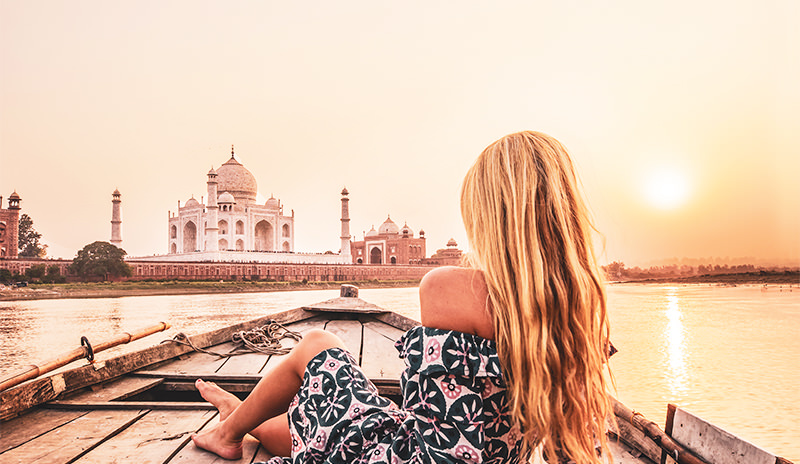 A distant view of the Taj Mahal from a boat on the Yamuna River
A distant view of the Taj Mahal from a boat on the Yamuna River
4) Though no dress code is enforced, moderate dressing is highly recommended.
5) There are three entry gates to enter Taj Mahal – South, East, and West. If you visit in the early morning, avoid the South gate as it doesn't open until 8 am. West gate is usually the most crowded, with many Indian visitors, but it is a better option at sunrise than the East gate which is close to many famous hotels and mostly used by foreign visitors. Remember to book tickets online to save time.
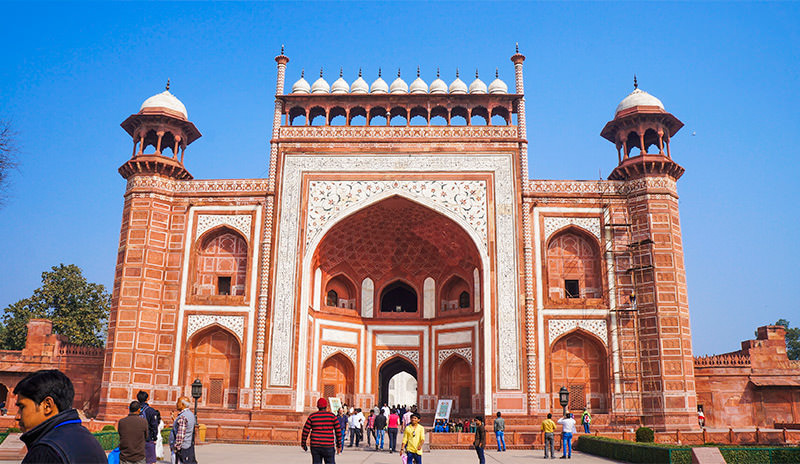 The South Gate of the Taj Mahal
The South Gate of the Taj Mahal
6) There has been a 3-hour visit limit in the monument since April, 2018.
7) There are certain things that are prohibited inside the Taj Mahal, including food, smoking items, other tobacco products and drinks, mobile phone chargers and tripods. If you do bring these items, you can keep them in the locker room at the entrance.
Plan Your Visit to Taj Mahal With Odynovo
Can't wait to visit Taj Mahal? Now is a good time to plan your India tour. Just let us know your requirements via [email protected] and one of our specialists will be in touch to create a unique India travel plan for you at no cost.
Quick Question
What Our Clients Say
Explore the latest verified reviews of Odynovo's travel services on Tripadvisor, Google, Trustpilot, Product Review and more trusted platforms.
SUBSCRIBE TO WIN A FREE TOUR
Subscribe to our newsletter for a chance to win a free 7-day tour to India! And more insider travel news, exclusive offers, and inspiration will be sent straight to your inbox. Check our previous newsletters and get some sparks.

